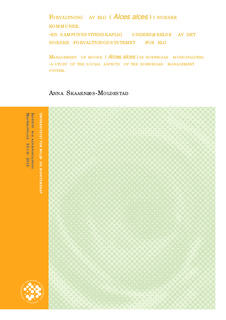Forvaltning av elg (Alces alces) i norske kommuner : en samfunnsvitenskaplig undersøkelse av det norske forvaltningssystemet for elg
Master thesis

View/
Date
2012-06-18Metadata
Show full item recordCollections
- Master's theses (INA) [593]
Abstract
De siste førti årene har elgbestandene hatt en eksplosjonsartet vekst her i landet, og dette har forvaltningssystemet måttet tilpasse seg. De store og produktive elgbestandene har ført til store
utfordringer, blant annet i forhold til fordeling av kostnader og nytte som er knyttet til arten og store samfunnsøkonomiske tap i forbindelse med trafikkulykker. Det å forvalte en naturressurs (for eksempel elg) er en kombinasjon av naturvitenskaplige og
samfunnsvitenskaplige oppgaver. I denne masteroppgaven har jeg undersøkt den
samfunnsvitenskaplige delen av det norske elgforvaltningssystemet. Dette ble gjort gjennom en spørreundersøkelse som ble sendt til de kommunalt ansvarlige for elgforvaltninga i de 332 kommunene som hadde åpnet for elgjakt i 2011.
Undersøkelsen fikk 84 % svar, og resultatene tegner et stort sett fredelig bilde av situasjonen i kommunene. Blant interessante resultater kan det nevnes at det har vist seg at norsk ungdom er
mindre engasjerte i forbindelse med elgforvaltninga enn sine foreldre og besteforeldre. Dette kan sees
i sammenheng med rekrutteringsproblemene som beskrives i elgjaktmiljøet, og understrekes også av
resultatene som viser at høy interesse for elgjakt blant kommunenes innbyggere sammenfaller med sterkt engasjement rundt forvaltningsprosessen. Undersøkelsen viser også at er det er få kommuner som har utarbeidet egne mål for forvaltninga. Dette må forandre seg etter at en ny forskrift om forvaltning av hjortevilt ble innført i februar 2012. Videre har det vist seg at de aller fleste kommunalt
ansvarlige bruker under 20 % av sin arbeidstid på oppgaver knyttet til elgforvaltning, noe som tilsvarer 5 ukeverk i snitt årlig. Dette kan variere fra år til år i forbindelse med flerårige planer.
Elgjakta er økonomisk viktig i omtrent halvparten av kommunene, og det er fortsatt noen få kommuner som ikke har kommunale viltfond. Undersøkelsen avdekker også at forvalterne savner mer
nøyaktige og pålitelige metoder for bestandsestimering som kan generere et bedre fundament for forvaltningsbestemmelsene. The last forty years, the populations of moose (Alces alces) in Norway have had an explosive growth, to which the management system has been forced to adapt. The large and productive populations have
led to major challenges, including the distribution of costs and benefits associated with the species and
huge socio-economic costs associated with traffic accidents. To manage a natural resource is a combination of natural- and social science. In this thesis, I examined the social aspects of the Norwegian system for management of moose. This was done
through a survey which was sent to the person who is responsible for the management in the 332 municipalities that had opened for moose hunting in 2011.
The survey got 84 % response, and the results demonstrate a generally peaceful picture of the situation in the municipalities. Among the interesting results, it can be mentioned that Norwegian youth are less
committed to the management of moose than their parents and grandparents. This can be seen in the context of recruitment problems described in the community of hunters, and are also underlined by the
results showing that high interest in hunting among the municipalities' inhabitants correlates with strong commitment to the management process. The survey also shows that there are few
municipalities that have developed their own goals for the management. This will have to change after the introduction of new regulations in the management of cervids in February 2012. Furthermore, it
has been shown that most municipal administrators spend less than 20% of their working time on tasks related to management of moose, which corresponds to an average of five weeks of work
annually. This can vary from year to year, associated with plans that last for more than one year. Moose hunting is economically important in about half of the municipalities, and some of them do not
have a wildlife fund. The survey also reveals that the managers want more accurate and reliable methods for population estimation, which can generate better foundation to the management
provisions.